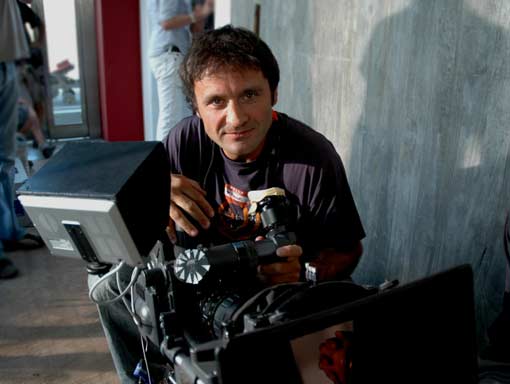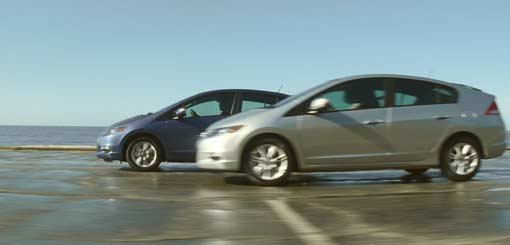With DP Eric Treml's Trick Photography, No Green Screens Required

Watch the spot, below, then read on as cinematographer Eric Treml explains how it was shot.
Cinematographer Eric Treml says that 95 percent of the signature “reveal” shots of the cars were accomplished with in-camera techniques rather than by elaborate computer manipulation in post-production. Significant compositing and rotoscoping was necessary for clean-up, but there was not a single green screen shot.

Cinematographer Eric Treml
“There’s something brilliant and beautiful about the physicality of doing these shots in the camera,” says Treml, originally from Salzburg, Austria. He studied architecture in Vienna prior to coming to the U.S. to pursue a career in cinematography. Upon his arrival in 1992, he worked as a camera technician at Clairmont Camera.
For the Honda campaign, extensive rehearsals with choreographer Michael Rooney and careful tech scouting were essential ingredients. With the help of GPS calculations and Google maps, each shot was lined up precisely and positioned advantageously with the sun, choreography and revealing actions in mind. Many of the shots required 20 or more takes to achieve the casual, relaxed feeling seen on film.
To accentuate a horizontal look, Treml and the directors chose to film the spots in anamorphic format in widescreen 2.4:1 aspect ratio. Viewers with high-definition televisions will see the spot in that aspect ratio, letterboxed, while viewers with 4:3 television sets will see the spot letterboxed in a 16:9 frame.
Treml brought Primo anamorphic lenses, provided by Panavision Woodland Hills, to the tech scout. “We generally chose longer lenses because the compressed perspective helped to hide things and achieve the right effect,” he says. “The car also looks great with longer lenses. I suggested flaring the lens to get those beautiful blue streaks and the directors loved it.”
In some shots, the directors asked Treml to keep the foreground and deep background in focus in order to visually link elements that would be combined later. “That meant we were shooting at stops T16 and T22 to get as much depth as possible,” Treml explains. “They wanted everything to be sharp. People at Panavision assured us this wouldn’t cause any issues with the lenses. This was also one reason we used 5219, a tungsten-balanced film, even though we were shooting exteriors.”
Treml says he needed the extended latitude of the KODAK VISION3 500T 5219 emulsion. “I love this film” he says. “It’s such a fine-grain, gorgeous stock with 14 stops of latitude. It digs into shadows beautifully. These days, especially with cars, you don’t go moody or cross process ‘ you give them a solid negative. If at any time they want to see more details, they have it.”
Treml augmented existing sunlight with Maxi-Brutes and Dinos. “We had some trouble with the weather at the beach,” he reports. “It was quite overcast, almost stormy at times. I like using Dinos as my keylight, or to dig into trees or to extend the sun. I often use a ½ blue gel on the Dinos and HMIs to fill the shadows. For example, for shots inside the cars, I used the Dinos with the ½ blue and a very light diffusion to give the actors a bit more edge.”
Shadows were a major issue. The filmmakers had to decide where to leave out shadows of actors and cars before they were revealed, and at which point they should be introduced to keep the images ringing true. “We always shot clean passes with no people and sometimes no cars in order to have the option of removing or introducing shadows as objects and subjects appeared,” says Treml. “The post-production team had its hands full with these decisions.”
The filmmakers also resorted to digital compositing techniques for a rack-focus shot that was physically impossible. “The shot called for a rack focus from a reflection back to a parking attendant,” he says. “It was a wide-angle shot with macro focus pulls, which in this case wasn’t possible in the anamorphic world. Instead, we shot all the layers and accomplished the rack in post.”

Treml collaborated closely with colorist Sparkle at Technicolor in Los Angeles. “I give them a solid negative, so they can play with it, but I set a look that I believe in with my colorist,” he says.
“The big challenge was how detailed each shot needed to be,” he continues. “Lining everything up was painstaking and time-consuming. We were chasing the light and there was only so much we could do considering that we often needed 30 takes. But the finished spot unfolds in a witty and delightful way.”
Did you enjoy this article? Sign up to receive the StudioDaily Fix eletter containing the latest stories, including news, videos, interviews, reviews and more.









Leave a Reply